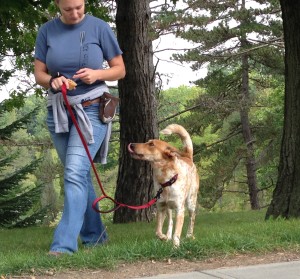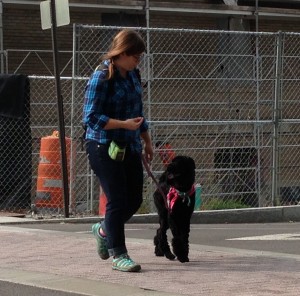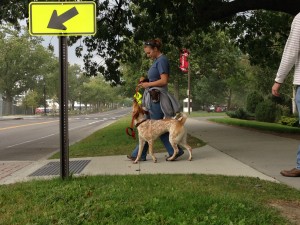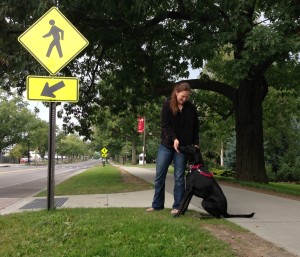by Sophie Liu, CDBC, Doggedly Devoted Summer Training Associate

Nothing is more stressful about our dogs than poor leash behavior. To counter leash pulling, people have come up with an enormous variety of tools to better control dogs, some better than others. Walk into any pet supply store, and you’re sure to see chain collars, prong collars, head collars, front-leading harnesses, etc. And, yet, loose leash walking isn’t as hard to achieve as you might think.
Just like a good diet and regular exercise, loose leash walking needs to become a good habit. In the next few weeks, we’’ll be posting a series of articles that will help you sift through the different layers of training an enjoyable and reliable loose leash walk. We’ll show you the basics to get you started and also explain the deeper subtleties for you overachievers. There’s a bit of something for everyone here, so we hope you enjoy the next few blogs of our Loose Leash Walking series!
At its core, loose-leash walking requires just a few simple principles that need to be applied consistently and regularly:

Define what you want as a loose leash. For me, that means that my dog is on a slack leash on my left side (you can choose either your left or right side ). It also means that my dog can easily give me focus when I stop or give a simple cue.
Enforce your definition of a loose leash with ample food rewards and forward movement. Food rewards and forward movement all indicate to the dog that what she’s doing is “right”. If we reward her loose leash with food rewards and forward movement, she will continue trying to walk on a loose leash, and it will make the behavior stronger.

Remove rewards for any behavior that is outside your loose leash definition. In other words, remove all rewards for any behaviors that are undesirable. Pulling ahead, lunging forward, ignoring the handler are all behaviors that need to be decreased, so all of these undesirable behaviors should result in cessation of food rewards and stopping forward movement. In other words, as soon as your dog breaks the ideal walking behavior, abruptly stop and do not interact with your pup. Or, you can try abruptly turning around and walking the other direction. If your pup gets too excited, try removing your dog from the situation by standing quietly in a corner and waiting for her to calm down.
 Be consistent. Consistency = clarity = good communication. Dogs learn to ignore their handlers when their handlers give mixed signals, as was found in a recent study (1). When we – the humans – fail to give consistent verbal and physical cues, our dogs get confused and learn to ignore us. We hurt – not help – them when we talk excessively or give confusing signals. Your actions really do speak louder than words, so be mindful of all your verbal and physical cues and use only what is necessary. Less truly is more.
Be consistent. Consistency = clarity = good communication. Dogs learn to ignore their handlers when their handlers give mixed signals, as was found in a recent study (1). When we – the humans – fail to give consistent verbal and physical cues, our dogs get confused and learn to ignore us. We hurt – not help – them when we talk excessively or give confusing signals. Your actions really do speak louder than words, so be mindful of all your verbal and physical cues and use only what is necessary. Less truly is more.
Let’s say you’ve tried all this before but are still struggling to gain that wonderful loose leash walk. What’s missing? Stay tuned for our next blog post on the importance of a strong foundation and how to train it!
- Pettersson H, Kaminski J, Herrmann E, Tomasello M. 2011. Understanding of human communicative motives in domestic dogs. Applied Animal Behaviour Science 133 (3-4) 235-245.